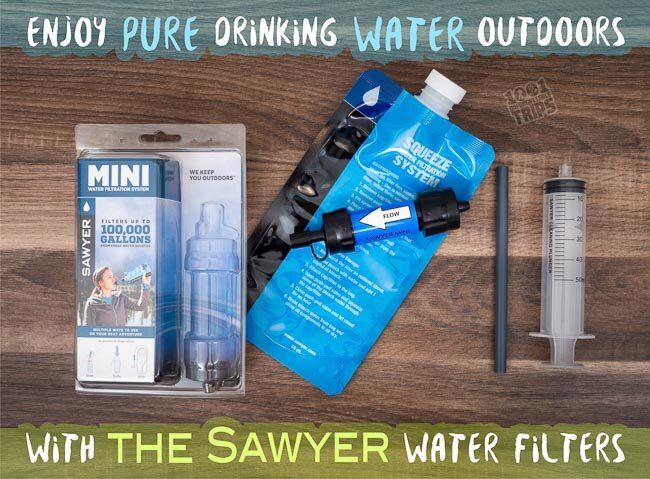
Enjoy pure drinking water outdoors with the Sawyer water filters
Water Filters and Filtration Systems
The US-based company produces insect repellents, first aid kits and sun screen, but it’s best-known for its water filters:
- Filters from the Point ZEROTWO system trap and remove virtually all particles larger than 0,02 microns (that’s where the name comes from): this include virtually all harmful substances, such as bacteria, protozoa, cysts and all known viruses able to survive in water. Filters based on this system are perfect for use in third-world countries, but an overkill for outdoor activities.
- In a process very similar to medical dialysis, filters from the PointONE system use micro-fibrous tubes to trap and remove any particles larger than 0,1 microns (that’s where the name comes from). This includes 99,99999% of all harmful bacteria (salmonela, cholera, E. coli), protozoa (cryptosporidium and giardia) and cysts, which makes them perfect for outdoor activities, where you are mostly filtering clear, moving water.
So let’s concentrate on the filters from the PointONE system now: the and . Both have won various awards and are the first choice of many outdoor experts for use in camping, hunting, fishing, multi-day hikes and in emergency kits.
| Sawyer Mini | Sawyer Squeeze | |
|---|---|---|
| Size | 3,4 x 13 cm / 1.34 x 5 in | 4,5 x 13 cm / 1.75 x 5 in |
| Weight | 48 g / 2 oz | 85 g / 3 oz |
| Sold in a set | SP128: includes the Sawyer Mini, 16 oz. pouch, cleaning syringe, drinking straw | SP129: includes the Sawyer Squeeze, 32 oz pouch, cleaning syringe SP131 (discontinued): includes the Sawyer Squeeze, 16, 32 and 64 oz. pouches and a cleaning syringe |
| Lifetime Output | Filter up to 100 000 gallons of fresh, moving water (from lakes, rivers and streams). | Filter up to 1 000 000 gallons of fresh, moving water (from lakes, rivers and streams). |
The two filters also remove the bad taste that comes from bacteria, dirt and green matter. If used properly and backwashed in regular intervals (see below), they can be used for a lifetime.
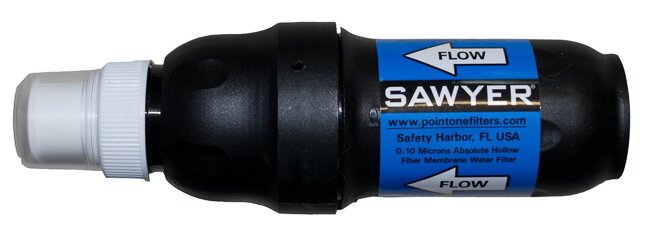
Sawyer Squeeze Filter
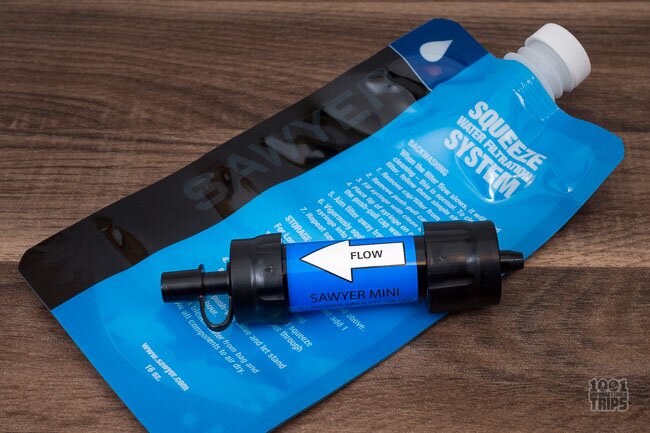
Sawyer Mini
Differences between the Sawyer Mini and Sawyer Squeeze
The two filters are based on the same filtering technology (0,1 micron pores), so the quality of the drinking water they produce is the same.
The filters are however different:
- The Sawyer Mini is smaller, lighter and costs less. And its two ends are compatible with most hydration bladders (water bags).
- The Sawyer Squeeze has about a 3x faster water flow and is expected to filter 10x more water. Also some users of both filters report that the Squeeze can be used for longer periods before it’s necessary to backwash it. The disadvantage is that to use the Squeeze with a hydration bladder, you’ll need to purchase the .
For our first water filter we chose the Sawyer Mini, and we are very happy with it. However if you spend a lot of time outdoor and especially if you are out with a group of people, you might want to select the larger and faster Sawyer Squeeze.
Limitations
- The Sawyer filters, like virtually all other water filters, should never be allowed to freeze if they are even remotely damp. See below for further details.
- Sawyer also recommends that the filters are never used with water hotter than 60°C / 140°F.
- Both the Sawyer Mini and the Sawyer Squeeze are based on the PointONE filtration system, which means that they cannot filter out viruses. As we clarified above, this is not a problem for normal outdoor use where you are filtering clear, moving water. However if are planing to travel to third-world countries and expect to come in contact with virus-contaminated water (specifically hepatitis and polio), then get a .
- None of the Sawyer filters use active coal, so they cannot remove contamination with heavy metals, pesticides or other chemicals. This too is not a problem for normal outdoor use.
- Unfortunately it’s also not possible to filter sea or ocean water, since those salts are completely dissolved in the water.
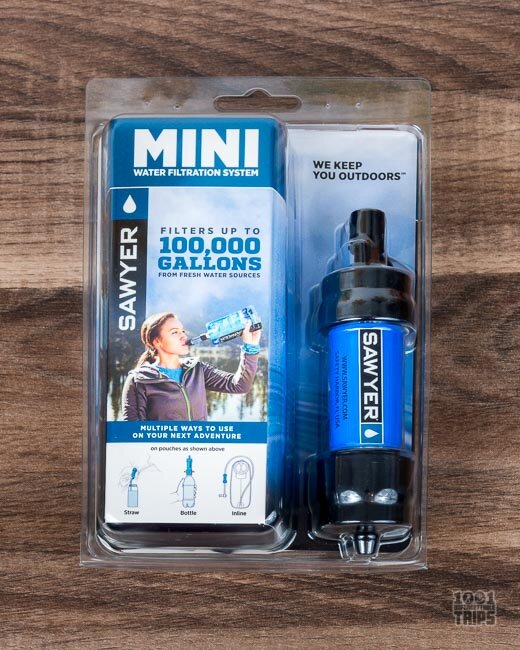
How to Use
There are many different ways to use the PointONE filters, but they all follow the same principle:
- Your Sawyer filter will do great things to any water you find in nature, but it’s always best to start with the best possible water quality you can find. Ideal are shallow mountain streams with clear water quickly running over stones. The slower the water is moving and the more green or brown matter it contains, the harder your filter has to work and the more important it is to clean it properly afterwards.
- Your filter has a big, fat white arrow showing the correct water direction. Fill up the supplied pouch (or another container) with “dirty” water and attach it to the dirty end of the filter. Note: we’ve found that the pressure of a flowing stream is usually not enough to “inflate” the sturdy pouch open, so one of us usually blows some air into the pouch before we hold the pouch under or inside the dirty water.
- Gently squeeze the pouch, suck on the clear end of the filter or turn the whole thing such that water naturally flows down through the filter and fills up a container with clean water. Even though the pouches are very durable, be gentle and don’t press your luck too much :).
Note 1: The water flow will increase a few seconds after starting to filter the water. The flow will also increase after the first few times you use your new filter. This is normal.
Note 2: If you feel that the water is flowing slower than it normally does, you should probably clean your filter instead of pressing harder on the pouch.
Note 3: The thread on the “dirty side” of the filters is compatible with most plastic bottles. When you use a plastic bottle to hold dirty water (the picture below right), pierce the bottle at the bottom or even cut the bottom off so that air can get in. Otherwise vacuum will be created and the water will quickly stop flowing.
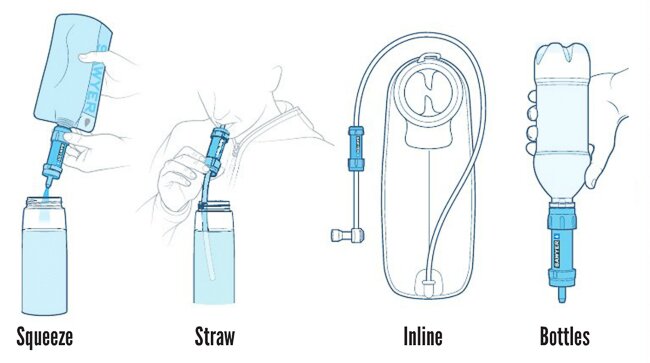
Above you see some configurations, which work really well with the Sawyer Mini. To use the Sawyer Squeeze with a straw or inline you’ll have to purchase the .
How to Clean
Your filter removes all particles larger than 0,1 microns from the water by trapping them inside its corpus. And depending on how dirty the water is which you are filtering, after a dozen or so filtrations you will probably start seeing a reduction of the flow of water. At the latest now you should clean your filter so that the trapped particles don’t clog it completely.
Sawyer filters are very easy to clean. Just fill the supplied syringe with clean water, attach the tip of the syringe to the clean end of the filter and vigorously squirt the water backwards through the filter. This process is called backwashing, and it should be repeated about a dozen times, each with a good bit of pressure.
When you are finished, shake the water out of your filter vigorously until no more visible water drops come out. Allow the filter to dry in a warm and sunny place.
The recommendations about how often you should backwash vary between “every couple of days” and “at the end of your trip.” Sawyer themselves recommend backwashing whenever the water flow slows down.
Long-Term Storage
Sawyer recommends that before you put away the filter for a few weeks (or months) you perform a normal backwash, and then:
- Fill the pouch with water and add one cupful of bleach.
- Attach the pouch to the filter and squeeze about half of the water through.
- Close the cap on the clean end of the filter and let it sit for an hour with the pouch attached.
- Drain the water, shake as much water off as you can, then let everything dry in the air.
- Store in a dry cool place, but make sure that the filter will not be exposed to freezing temperatures.
IMPORTANT: Take care when using in winter
As you surely know, when water freezes, it expands. So if your filter is wet or even just a tiny bit damp and you let it freeze, the water inside the membranes will break off those extremely fine membranes, and your 0,1 micron filter will probably turn into a 1 or 10 or even 100 micron strainer. Nothing you want to trust your health to!
Therefore: if you have even the slightest expectation that the temperatures outside might go below freezing, make sure that your filter is stored in a warm place. The easiest way is to carry it in an inside pocket, close to your body. At night put it inside your sleeping bag.
There are two exceptions to this rule:
- If your filter is brand new, it’s never been in contact with water yet, so freezing is not a problem.
- If your filter hasn’t been used for weeks and you are absolutely sure that it’s dry.
There is an easy way to test if your filter might be damaged due to freezing: run about 1 liter of water through the filter then shake out the water from the inside. Now try to blow air with your lips through the filter (dirty side towards clean side). Give it a strong blow. If you are able to blow air through the filter, it’s damaged through freezing. (Note that this test is only valid if the filter is wet. If it’s completely dry, it’s normal that some air travels through.)
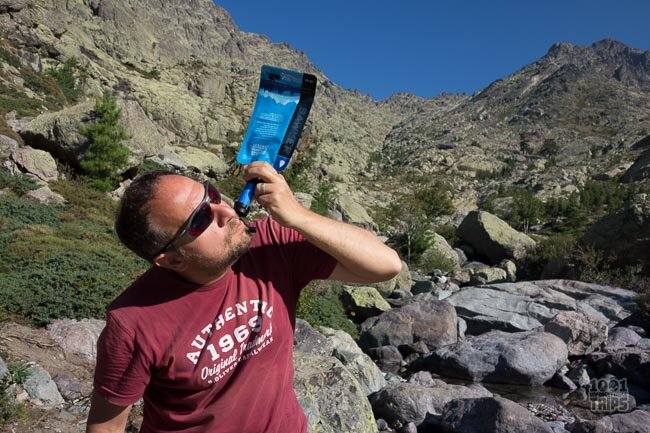
Bojidar enjoying fresh drinking water straight from the Sawyer Mini
GR20 hike across Corsica, September 2015
Alternatives to Sawyer
Even though many outdoor experts swear by the Sawyer products, there are other brands and other water filtering technologies: chemical purifier tablets, filters which work with UV light, filter straws, gravity filters and pump filters.
by the Outdoor Gear Lab explains the differences, advantages and disadvantages of all these systems. But you can also save your time: that article too lists the Sawyer Mini as their “Best buy”, and the Sawyer Squeeze is among the top 5.
Our Recommendations
If you prefer low weight and small size, go for the Sawyer Mini.
If you can spend another 15 EUR, carry an additional 40 grams and a slightly larger filter, you’ll probably be even happier with the Sawyer Squeeze due to its faster water flow and longer periods between cleaning.
We really hope you enjoyed this review. If you have any further questions or want to share your own experiences with using the Sawyer filtration system please leave a comment below.
| List Price: | Price: | You Save: | List Price: | Price: | You Save: |




